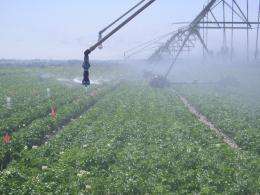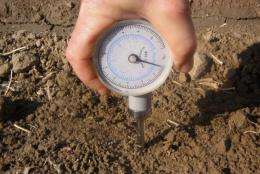USDA irrigation research: Good to the last drop

U.S. Department of Agriculture (USDA) scientists are ensuring that farmers in the Pacific Northwest are benefiting from every drop of crop irrigation water.
Agricultural Research Service (ARS) soil scientist Gary Lehrsch has developed irrigation guidelines to protect soil structure, maintain soil quality, sustain soil resources, and improve the delivery of water distributed via sprinkler irrigation to the root zones of growing crops.
ARS is USDA's chief intramural scientific research agency, and this work supports the USDA priorities of responding to climate change and promoting international food security.
Lehrsch works at the ARS Northwest Irrigation and Soils Research Laboratory in Kimberly, Idaho. In one 5-year investigation, he and colleagues evaluated the effect of sprinkler droplet kinetic energy on soil crust strength and aggregate stability. They irrigated sugar beet plots using sprinkler systems equipped with spray heads mounted six feet above the soil.

The spray heads were modified to produce water droplets having either low- or high-droplet energies. The team measured aggregate stability and surface soil penetration resistance-a measure of crust strength-about four days after the first postplant irrigation and 14 days after the last irrigation.
Lehrsch and his colleagues found that the portion of stable soil aggregates decreased from 66 percent to 55 percent when the irrigation's energy increased from 0 percent (in test plots protected by nylon netting) to the lowest rate under investigation. Even more importantly, they found that sugarbeet seedling emergence increased 6.4 percent when droplet energy was reduced 50 percent, an emergence increase that could raise net income for southern Idaho sugar beet growers by nearly $6.2 million every year.
The scientists concluded that these restrictions should be in place until sugarbeet seedlings have emerged and become established. Then the sprinklers can be reconfigured to apply greater water volumes, at necessarily greater levels of energy, for the rest of the growing season.
More information: Read more about this research in the May/June 2012 issue of Agricultural Research magazine.
Provided by Agricultural Research Service















